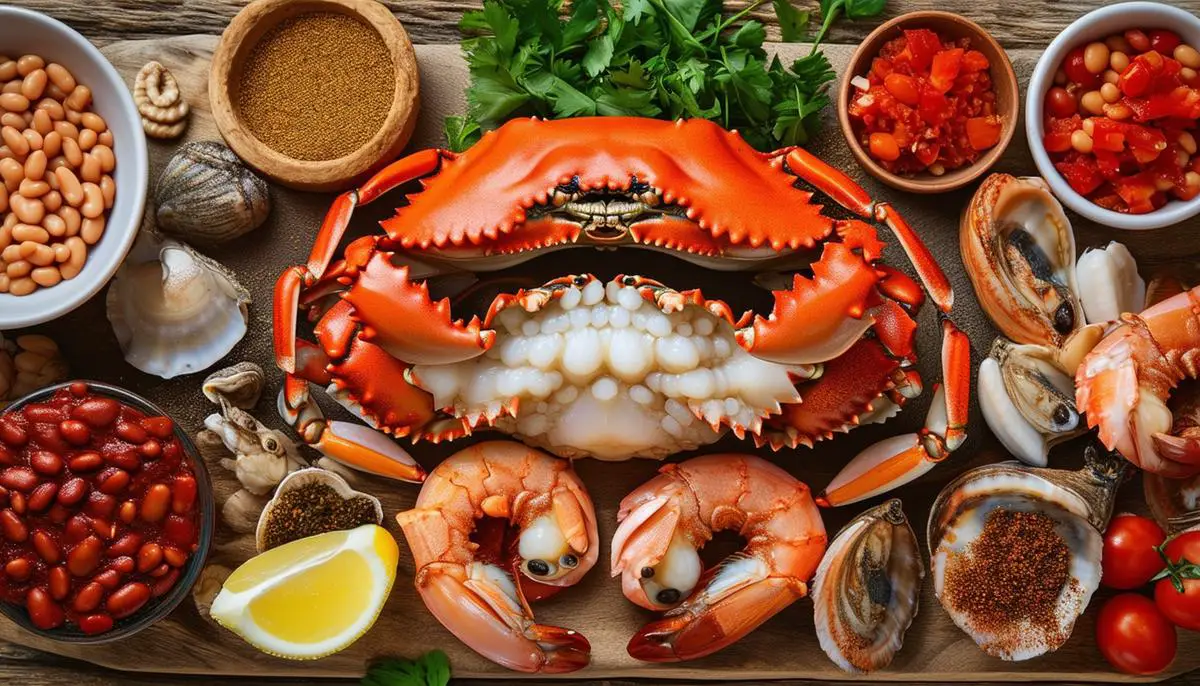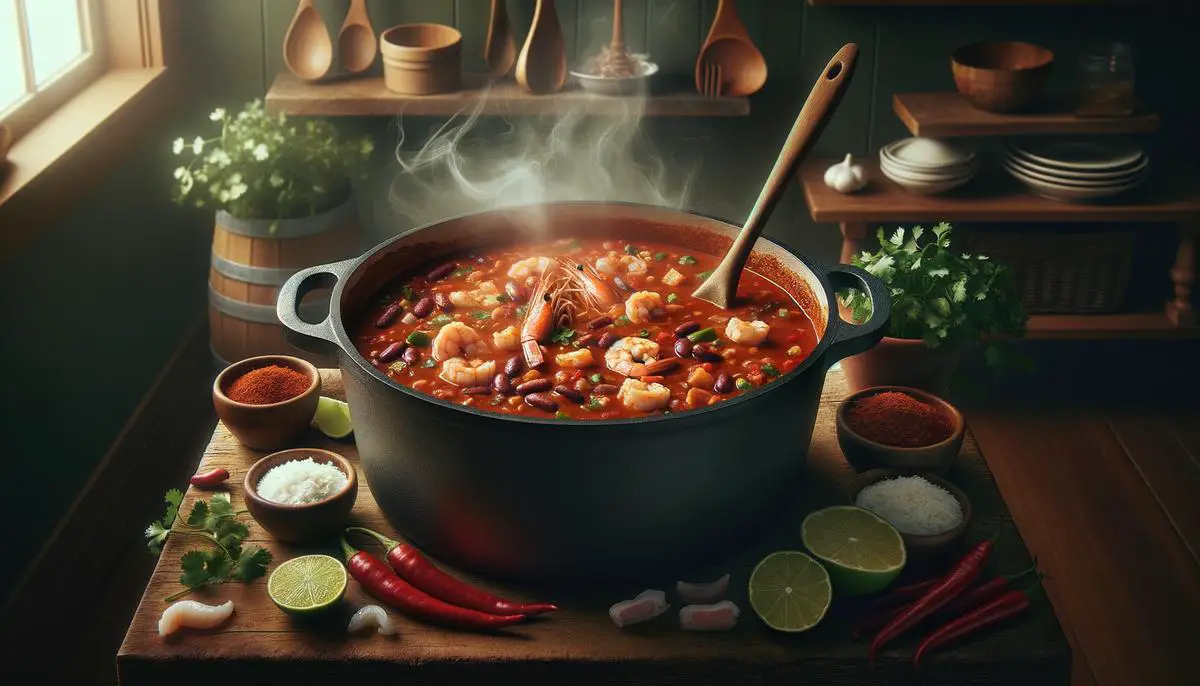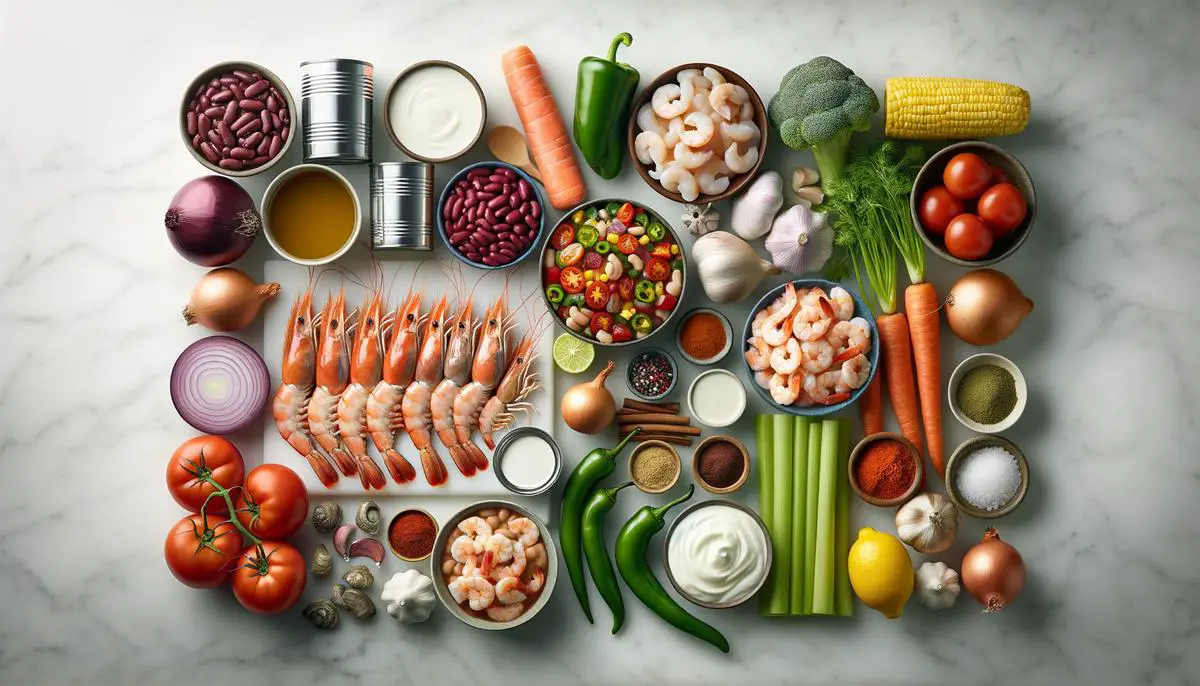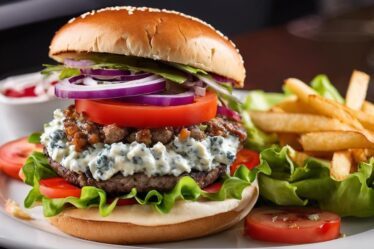
Background and Personal Anecdotes
Picture this: a quaint, rustic restaurant with a view of the crashing waves and the aroma of succulent seafood wafting from the kitchen. As a Texan raised on traditional beef chili, I had my reservations about seafood chili. I mean, chili without beef? But I was feeling adventurous and decided, why not?
Oh boy, was I in for a treat! One spoonful, and I was hooked. The sweetness of crab meat, the delicate flavor of scallops, and the tender shrimp—each bite was a revelation. The combination of traditional chili spices with the zesty kick of lime and a hint of garlic made it even more delightful. The vegetable broth tied everything together without overshadowing the seafood and beans.
Seafood chili captures the essence of coastal living—fresh catches right from the ocean, locally sourced vegetables, and the inviting warmth that chili recipes traditionally offer. In regions where fishing is a way of life, seafood chili symbolizes the seamless blend of sustenance and indulgence, making every meal a celebration of the land and the sea.
Seafood chili's ability to surprise and delight is what makes it so special. It's a masterpiece of culinary creativity, a testament to the flavors of the ocean and the inventive spirit of those who love to merge traditions with novel twists.
So, if you ever doubted whether seafood could find its place in a hearty chili, let me assure you, it's a match made in seafood heaven. Dive into the recipe, embark on a flavor adventure, and who knows, maybe you'll create your own unforgettable memory with this extraordinary dish. Trust the journey; the sea has so much more to offer than just waves and fish.

Tips for Perfect Seafood Chili
Let's get to the nitty-gritty of making seafood chili that's out of this world. This dish deserves only the best of your effort and ingredients.
Selecting fresh seafood is key. Always aim for the freshest crab, shrimp, and scallops you can find. If fresh seafood isn't available, frozen is your next best bet—just make sure to thaw it properly.
Cooking the seafood is where many folks trip up. Overcooked shrimp and scallops become rubbery and just plain sad. Keep a close eye on the timing—shrimp cook up fast, around 2 to 3 minutes, turning opaque when they're done. Scallops aren't far behind; they'll be ready in about 10 minutes of gentle simmering.
Seasoning is another crucial element. Chili powder, cumin, salt, and pepper form the base, but don't be afraid to add your flair. Lime juice adds a refreshing tang, while garlic and cilantro bring depth and warmth. Balance is key, so taste as you go and adjust those seasonings to your liking.
A Dutch oven is recommended for its heavy bottom that ensures even cooking and helps maintain a steady simmer, making it perfect for chili. If you don't have one, any heavy-bottomed pot will do, just keep an eye on those simmering conditions.
Want it dairy-free? Swap the heavy cream for coconut cream. It adds a subtle sweetness and richness without the dairy. Have scallops but no shrimp? No problem, just adjust the cook time since scallops will need a bit longer. Beans are flexible too—mix and match based on what you have in your pantry.
Chili is versatile, so garnish with anything you love—sour cream, shredded cheese, jalapeños, avocado—they all add great texture and flavor.
So there you have it, folks! A treasure trove of tips to make your seafood chili the star of your dinner table. Happy cooking!
Types of Seafood to Use
When making seafood chili, variety is your best friend. Each type of seafood contributes its own unique flavor, texture, and character to the dish, creating a medley of tastes that's both multifaceted and satisfying. Here's a detailed look at the different types of seafood you can mix and match in your chili:
Shrimp: One of the most common additions, shrimp brings a sweet, slightly briny taste that complements the chili spices well. Opt for raw, peeled, and deveined shrimp. They cook quickly and can easily become overcooked, turning rubbery if not watched closely.
Scallops: These gems of the sea offer a delicate sweetness and firm texture that hold up beautifully in a simmering pot of chili. Bay scallops are smaller and cook faster than sea scallops, making them a good choice for quick-cooking recipes. Fresh scallops should be firm and have a fresh, ocean-like smell.
Crab Meat: Crab adds a rich, sweet flavor to your chili. Fresh crab is always the best choice, but canned crab meat is a convenient alternative. Look for lump or claw meat for the best texture. Be sure to check it for any stray bits of shell before adding it to your chili.
Lobster: For a luxurious touch, include lobster meat in your chili. Its tender texture and subtle sweetness can elevate your dish. Lobster tails or claw meat are typically the best options. Buying pre-cooked lobster can save prep time, but using fresh lobster will give you the best flavor.
Mussels: These bivalves bring an earthy, salty taste to your chili. Mussels cook quickly, usually in about 5 minutes once their shells open. Fresh mussels should be tightly closed and smell like the sea.
Crawfish: A staple in many Southern dishes, crawfish has a flavor that's somewhere between shrimp and crab. Buy them pre-cooked and peeled for convenience, but if you're feeling adventurous, you can cook and peel them yourself.
Clams: These add a briny, chewy element to your chili. Fresh clams should also be tightly closed and smell fresh. Cook them until their shells open, discarding any that stay closed.
Tips for Handling and Storing Seafood
- Buying Fresh Seafood: Look for seafood that smells fresh and has no off-putting, fishy odors. The flesh should be firm, not slimy, and shellfish should be tightly closed.
- Frozen Seafood: A good alternative when fresh isn't available. Frozen seafood can be just as tasty as fresh if it's properly thawed. Thaw it in the refrigerator overnight or under cold running water if you're in a hurry.
- Storage: Store fresh seafood in the coldest part of your refrigerator and use it within a day or two. For longer storage, many types of seafood can be frozen. Wrap it tightly to prevent freezer burn and label it with the date.
- Handling: Keep seafood separate from other ingredients and use separate cutting boards and utensils. Always wash your hands thoroughly after handling any raw seafood.
No matter what type of seafood you choose, the key is freshness and proper handling. Each type brings something special to the table, creating a chili that's bursting with flavor and textures. Enjoy experimenting and finding your favorite seafood combinations!

Essential Ingredients and Equipment
One of the keys to making a mouth-watering seafood chili is using the right mix of ingredients and having the essential kitchen equipment on hand. Let's explore the essentials:
Onions and Garlic: These two are the aromatic foundation for many savory dishes, including seafood chili. Onions offer a sweet, slightly acidic baseline, while garlic adds depth and a touch of earthiness. Both are sautéed at the start to release their flavors, forming a robust base for the rest of the dish.
Various Beans: Beans add heartiness and protein. For seafood chili, a mix of great northern beans, black beans, and red kidney beans provides a lovely contrast in both texture and color. Their mild flavors also allow the seafood and spices to shine.
Diced Tomatoes and Tomato Paste: Tomatoes bring acidity, sweetness, and a slight tang, which helps balance the spices and the rich flavors of the seafood. The tomato paste thickens the chili, providing a more intense tomato flavor and adding to the overall consistency.
Green Chiles: These offer a mild to moderate heat level and a bit of smokiness, boosting the chili's intricacy. Drain them well before adding to prevent watering down the chili.
Corn Kernels: Whether fresh or frozen, corn adds a touch of sweetness and a bit of crunch that contrasts nicely with the tender seafood.
Vegetable, Chicken Broth, or Shrimp Stock: This is the liquid backbone that brings all the flavors together. A good broth will infuse the chili with additional layers of depth. Shrimp stock, in particular, enhances the seafood notes in the dish, making it richer and more cohesive.
Chili Powder, Cumin, and Salt: These spices form the core seasoning, giving chili its characteristic warmth and depth. Chili powder has a mix of dried chilies and other spices, cumin adds an earthy, slightly spicy flavor, and salt heightens all the other flavors.
Lemon Juice: Fresh lemon juice adds a bright, zesty finish, cutting through the richness of the seafood and balancing the overall flavor profile.
Shrimp, Scallops, and Crab: These seafood staples bring their own unique tastes and textures. Shrimp add a sweet, briny flavor while crab offers a rich, slightly sweet note and scallops bring a delicate sweetness with a firmer texture.
Heavy Cream: This adds creaminess and richness to the chili, making it more luscious and filling without overpowering the seafood flavors.
Chopped Cilantro: A final sprinkle of cilantro adds a burst of color and a fresh, citrusy note that lifts all the other flavors, making each spoonful vibrant and delicious.
Key Kitchen Equipment
Dutch Oven: This heavy-bottomed pot is indispensable for making chili. It provides even heat distribution and maintains consistent temperatures, perfect for slow cooking and simmering.
Large Wooden Spoon: A sturdy wooden spoon is great for stirring without scratching the pot, and it's strong enough to manage the thick, hearty chili.
Mixing Bowls: Essential for preparing and holding ingredients, particularly when seasoning the seafood separately. Multiple sizes will come in handy as you prep and combine various components of the recipe.
With these core ingredients and essential tools, you're fully equipped to create a seafood chili that will undoubtedly become a favorite in your household.
Seafood Chili Recipe
This hearty and flavorful seafood chili is packed with tender shrimp, sweet scallops, and succulent crab meat in a rich tomato-based broth with beans and vegetables. Perfect for a cozy dinner or a crowd-pleasing meal, this chili is sure to satisfy your seafood cravings.
Ingredients For the Seafood Chili
- 2 teaspoons neutral oil (avocado oil, olive oil, etc.)
- 1 medium onion, finely chopped (approximately 1 ½ cups)
- 2 stalks celery, finely chopped (approximately 1 cup)
- 1 large carrot, finely chopped (approximately 1 cup)
- 4 cloves garlic, minced
- 1 14.5-ounce can petite diced tomatoes, drained
- 1 4-ounce can diced green chiles, drained
- 1 15.5-ounce can great northern beans, drained, rinsed
- 1 15.5-ounce can black beans, drained, rinsed
- 1 15.5-ounce can red kidney beans, drained, rinsed
- 2 cups vegetable broth or chicken broth, or shrimp stock
- 2 tablespoons tomato paste
- ½ cup corn kernels, canned or frozen
- 1 ½ tablespoons chili powder blend
- 1 teaspoon cumin
- 1 teaspoon salt (more or less to taste)
- ½ teaspoon freshly cracked black pepper (more or less to taste)
- Juice from 1 medium lemon (approximately 2 tablespoons, divided)
- 1 pound shrimp, raw, peeled, deveined
- 1 pound bay scallops
- 8 ounces fresh crab meat (claw, lump, or both)
- ⅓ cup heavy cream
- 1 handful finely chopped cilantro
Suggested Toppings (All Optional)
- Sour cream or Greek yogurt
- Shredded cheddar cheese
- Diced avocado
- Sliced or chopped jalapeños
- Hot sauce
Instructions
- Heat Dutch oven over medium-high heat. When warm, add oil and heat until shimmering.
- Add onion, celery, and carrots. Stir to incorporate, then cook until veggies have softened, about 5 to 6 minutes.
- Add minced garlic and cook until fragrant, about 3 to 4 minutes.
- Add tomatoes, green chiles, great northern beans, black beans, and red kidney beans. Stir well.
- Add broth, tomato paste, corn, chili powder, cumin, salt, and pepper. Stir well and cook 3 to 4 minutes.
- Reduce heat to medium-low, cover, and simmer 15 to 20 minutes, stirring occasionally.
- In a large bowl, add shrimp, scallops, 50% of lemon juice, salt, and pepper. Gently toss to coat.
- Add seasoned shrimp, scallops, crab meat, cream, and remaining lemon juice to the Dutch oven. Gently stir, cover, and cook until shrimp are opaque, about 8 to 10 minutes.
- Sprinkle cilantro over the top of the chili.
- Portion into bowls and top with desired toppings. Serve immediately.
Notes
- Chili Powder Blend: Make your own with chili pepper, paprika, sea salt, oregano, cumin, thyme, cayenne, and garlic powder.
- Bay Scallops: Use sea scallops cut into smaller pieces if bay scallops aren't available.
- Crab Meat: Scan the crab meat with your fingers to remove any shell fragments.
- Make it Dairy Free: Use coconut cream instead of heavy cream.
Nutrition Information
- Serving: 1 serving
- Calories: 555 kcal
- Protein: 49 g
- Fat: 10 g
- Saturated Fat: 4 g
- Trans Fat: 0.01 g
- Total Carbs: 71 g
- Fiber: 22 g
- Sugar: 8 g
- Net Carbs: 49 g
- Vitamin C: 26 mg
- Cholesterol: 144 mg
- Sodium: 1735 mg
- Potassium: 1700 mg
- Calcium: 232 mg
- Iron: 8 mg




